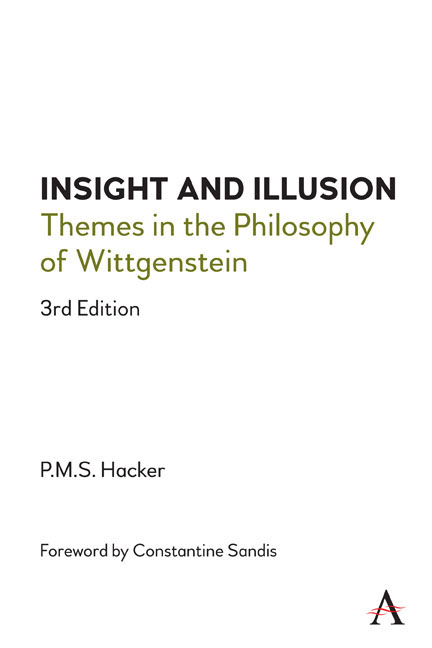Book contents
- Frontmatter
- Dedication
- Contents
- FOREWORD
- PREFACE TO THE REVISED EDITION
- PREFACE TO THE FIRST EDITION
- LIST OF ABBREVIATIONS
- I WITTGENSTEIN’S EARLY CONCEPTION OF PHILOSOPHY
- II THE DIALOGUE WITH FREGE AND RUSSELL
- III MEANING, METAPHYSICS, AND THE MIND
- IV EMPIRICAL REALISM AND TRANSCENDENTAL SOLIPSISM
- V DISINTEGRATION AND RECONSTRUCTION
- VI WITTGENSTEIN’S LATER CONCEPTION OF PHILOSOPHY
- VII METAPHYSICS AS THE SHADOW OF GRAMMAR
- VIII THE REFUTATION OF SOLIPSISM
- IX PRIVATE LINGUISTS AND PUBLIC SPEAKERS
- X ‘A CLOUD OF PHILOSOPHY CONDENSED INTO A DROP OF GRAMMAR’
- XI CRITERIA, REALISM AND ANTI-REALISM
- INDEX
FOREWORD
Published online by Cambridge University Press: 24 February 2022
- Frontmatter
- Dedication
- Contents
- FOREWORD
- PREFACE TO THE REVISED EDITION
- PREFACE TO THE FIRST EDITION
- LIST OF ABBREVIATIONS
- I WITTGENSTEIN’S EARLY CONCEPTION OF PHILOSOPHY
- II THE DIALOGUE WITH FREGE AND RUSSELL
- III MEANING, METAPHYSICS, AND THE MIND
- IV EMPIRICAL REALISM AND TRANSCENDENTAL SOLIPSISM
- V DISINTEGRATION AND RECONSTRUCTION
- VI WITTGENSTEIN’S LATER CONCEPTION OF PHILOSOPHY
- VII METAPHYSICS AS THE SHADOW OF GRAMMAR
- VIII THE REFUTATION OF SOLIPSISM
- IX PRIVATE LINGUISTS AND PUBLIC SPEAKERS
- X ‘A CLOUD OF PHILOSOPHY CONDENSED INTO A DROP OF GRAMMAR’
- XI CRITERIA, REALISM AND ANTI-REALISM
- INDEX
Summary
Hacker's Guide to Wittgenstein's Treasure
Constantine Sandis
Philosophers hunt for the map of Treasure Island in order to find the treasure, and they do not realise that the treasure is the map!
– P. M. S. Hacker, Insight and Illusion, p. 149I first got my undergraduate hands on Insight and Illusionin its 1997 Thoemmes Press reprint of the revised second edition, subtitled Themes in the Philosophy of Wittgenstein. While, at the time, I was a finalist at St Anne's College, Oxford, it was owing to sheer providence that I had been farmed out to Peter Hacker at St John's for my Philosophy of Mind tutorials. These sessions constituted not only my introduction to Wittgenstein, but also to the work of Elizabeth Anscombe, J. L. Austin, Arthur W. Collins, Anthony Kenny, Norman Malcolm, Gilbert Ryle, G. H. von Wright and A. R. White. Just as my degree (and, with it, also my interest in philosophy) was coming to an end, Peter opened up a whole new world to me. The door to that world was Wittgenstein's philosophy and the key to it was Insight and Illusion.
It is customary to say of books one adored as a student that they got one through college but, such was the hostility towards Wittgenstein's philosophy at the time within UK academia, that it would be closer to the truth to say that Insight and Illusionalmost stood in the way of my degree. Undaunted, I returned to it several times over the years to explore philosophy until I arrived where I had begun, knowing the place for the first time.
Insight and Illusionwas the first single-authored book to cover all phases of Wittgenstein's life and thought. The portable guide takes the reader through the major themes and concepts in Wittgenstein's works. In the name of exhaustiveness, these include the so-called picture theory of meaning; the say/show distinction; the principle of verification; antimetaphysics; anti-scientism; tautologies; the nature of mathematical propositions; ordinary language and nonsense; the law of the excluded middle; the Augustinian picture of language; knowledge and certainty; explanation and understanding; volition and the will; the relation of meaning to use; ostensive definition; ownership of experience; the first-person pronoun; the inner/outer; philosophical psychology; anti-solipsism; forms of life; the so-called private language argument; the autonomy of grammar; language games; and rule-following.
- Type
- Chapter
- Information
- Insight and IllusionThemes in the Philosophy of Wittgenstein, pp. xi - xivPublisher: Anthem PressPrint publication year: 2021



